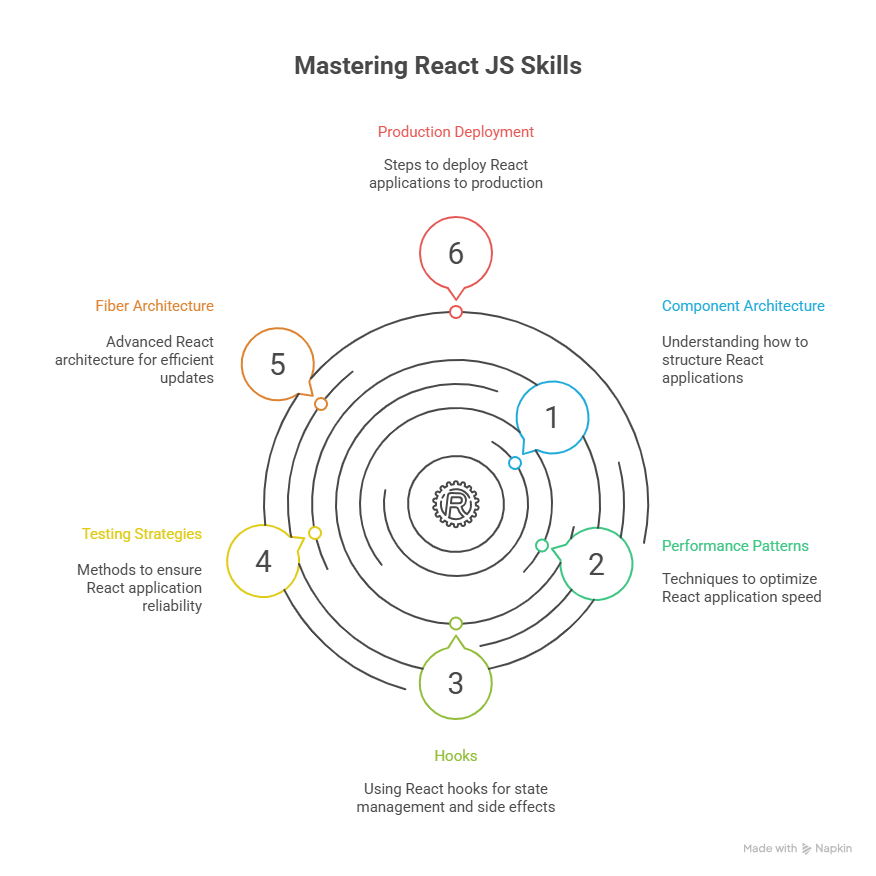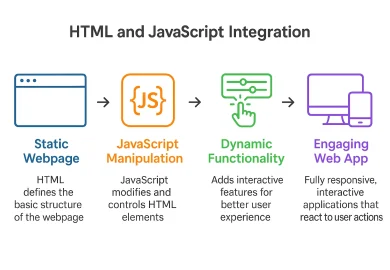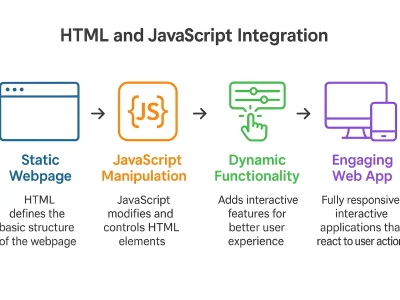In 2025, React will continue to influence the front-end development tech companies worldwide. The challenge lies in the framework’s evolving nature and broad concept coverage.
This article is an ultimate guide for React developers by offering 55 most important React JS interview questions and answers for 2025. From this, the developers can get insights into fundamental concepts, intricacies of React Hooks, Fiber architecture, Concurrent Mode, and some steps needed for testing and deployment. Did you know that React developers are earning an average salary of $129,000 annually. This highlights the vast career opportunities for developers in this field.
React JS interview Questions for Freshers
This section covers the core React concepts every fresher should know —like JSX, Virtual DOM, props vs. state, and basic component structures. Perfect for beginners preparing for their first React interview.
1. What is React, and why has it become the top choice for frontend development in 2025?
An open-source JavaScript library used to build User Interfaces. In 2025, it is widely accepted as the top choice for front-end development due to its unidirectional Data flow, platform compatibility, Virtual DOM, and reusable component-based architecture.
2. Explain Virtual DOM and its performance benefits with real examples.
A blueprint for UI or Real DOM (Document Object Model). If we make any changes to the application, React will first update its internal Virtual DOM, which helps to avoid internal or UI lags and a poor user experience.
3. What is JSX? How does it differ from regular HTML?
A JavaScript XML to write markup language within JavaScript files. The difference between JSX and regular HTML is the integration of code with JavaScript files to create a webpage. JSX tags can be closed with a trailing slash (/).
4. What are React components? Functional vs Class components in 2025.
A smaller piece of UI elements that has its logic and functions. In 2025, Functional components are used with Hooks to manage their state, whereas Class components are used in old libraries to manage internal state.
5. What are props in React? How to pass data between components?
Props are read-only inputs to pass attributes from a parent to a child class. The child component receives these props as an argument in both functional and class components.
6. What is the state in React? useState hook explained with examples?
A JavaScript object that represents dynamic data within a component. The useState hook enables the management of functional elements.
7. Explain the React component lifecycle
It involves mounting, rendering, using effects, updating, and unmounting.
8. What’s the difference between state and Props?
An attribute that comes from the parent class and is unidirectional, whereas a state is an attribute inside and can be changed by the component itself.
9. How do you handle events in React? (onClick, onChange examples)
Handling events in React is similar to handling events in HTML and JavaScript, but it provides a cross-browser compatible API. It uses onClick and onChange event handlers to respond to user interactions with the UI.
React JS JSX and Component Rendering Question (Questions 10-18)
Dive deeper into how JSX works and how components render in React. This section explains conditional rendering, list keys, styling methods, fragments, portals, and handling forms with real examples to boost your UI-building confidence.
10. What are the rules of JSX that every developer should know?
JSX follows camelCase attributes, single root elements, proper closing tags, and className instead of class.
11. How to implement conditional rendering in React? (5 different methods)
Conditional rendering in React can be implemented using five methods, namely the Ternary operator, Short-circuit evaluation, the logical && operator, if-else statements, and switch case statements.
12. What are React keys, and why are they essential for lists?
React keys are used to find out list items and shuffle them before remounting the lists. Instead of indexes, it uses IDs for each item to list and reorder.
13. Controlled vs. Uncontrolled Components – When to Use Which?
Controlled components – manage state via React, whereas Uncontrolled components – controlled by the DOM.
14. What are React Fragments and why use them?
It allows the JSX elements to group without any extra nodes in the DOM. It helps in rendering multiple groups.
15. How to style React components? (CSS Modules, Styled Components, Tailwind)
React components use Tailwind CSS as a utility-based framework, CSS modules for locally scoped styles, and styled components, like JS-in-CSS, for dynamic styling.
16. What is React.createElement() vs JSX?
It creates a React element, which is a description of what a user sees on the screen, whereas JSX is an XML extension of JavaScript.
17. How to handle forms in React? (Form validation examples)
Forms are handled using useState and validated with React libraries, such as React Hook Form. e.preventDefault() stops the default submit of a form.
18. What are React portals, and what are their use cases?
React portals allow elements to be rendered outside the central DOM hierarchy. It is used in Modals, Tooltips and Popovers, dropdowns, and third-party Integration.
React JS Interview Questions for Intermediate Developers (Questions 19-40)
This section focuses on mastering React Hooks like useState, useEffect, useContext, and useReducer, along with state management strategies, component communication, architectural patterns, and handling side effects—perfect for developers with 1–3 years of experience looking to level up.
19. What are React Hooks? Why were they introduced over class components?
It helps in the state and lifecycle features of functional components. Hooks are introduced over class components to have all the capabilities of class components in functional components themselves.
20. How does the useState hook – Complete guide with multiple examples
It helps to manage and update their state by functional components. It returns two values. For example, count is used to store the number, and setCount is used to change the value. Each interface updates the state and re-orders the components.
21. How does the useEffect hook replace lifecycle methods, and what are its best practices?
It interacts with the elements outside the component’s render scope. The best practice for useEffect is to specify a dependency array for mounting only, and include all dependencies in an array with separate concerns.
22. How does the useContext hook help avoid prop drilling? (Include a practical example)
ReactContext provides a global value that helps to avoid the manual passing of props. Example- the parent component is wrapped with UserContext.A provider that passes the needed value through its value proposition.
23. When should you use the useReducer hook instead of useState in React applications?
It handles Redux or state management libraries. useReducer is used instead of useState in React where state transitions involve multiple sub-values or the subsequent state depends on the last state, and passing down the dispatch function.
24. What is the useMemo hook, and how does it help with performance optimization in React?
It caches the result of a function call. It optimizes the performance by re-running on every render for changed dependencies to prevent expensive calculations.
25. How does the useCallback hook prevent unnecessary re-renders in functional components?
If any of the functions is recreated on each render, it will lead all the customers to rerender the context. The useCallback hook ensures a stable reference by memoizing the function.
26. What is the useRef hook used for? Understanding DOM manipulation and persistent values
It accesses the DOM nodes directly with a persistent value. Changing .current value does not trigger a re-render using useRef hook. useRef is used for component values that don’t affect its visual output.
27. What are custom hooks in React, and how can you build one like useLocalStorage?
It reuses the linkage across components. useLocalstorage hook helps to ensure the React state is in sync with the browser’s localstorage. We can use useState(getStoredValue). Here, the function getStoredValue will run only once on the initial render to stop unnecessary localStorage reads on every re-render.
28. What are the rules of hooks in React, and why must they never be broken?
Hooks must be called from the top-level React functions. It should not be used in loops or conditions and should be used only in React components or custom hooks.
29. What’s the difference between useLayoutEffect and useEffect, and when should you use each?
It runs the function before the browser has composed the changes to the screen, whereas useEffect is used to run the function after the browser has composed the changes.
30. How do hook dependency arrays work, and what are common mistakes developers make when using them?
During renderings, React performs a quick comparison between the values in the dependency array. If it observes any changes from the last render, it will re-calculate the memoized value or function.
State Management & Architecture (Questions 31-40)
Dive into key concepts of local vs global state, prop drilling, lifting state up, React Context API, Higher-Order Components (HOCs), and scalable architecture patterns to build maintainable, large-scale React applications efficiently.
It decides who owns the data over time within the application. Local state is used in single React components, such as input fields of a form or Toggle states. In contrast, global state is used in multiple components, such as theme preferences or profile information, throughout the application.
32. When and how should you lift state in a React component hierarchy?
We can lift state in a React component where multiple components require common or synchronize with the same data. To elevate the state, we need to find the common ancestor to identify the state and pass it, along with the updater, as props.
33. What is prop drilling in React, and what are four practical ways to avoid it?
It passes data through multiple layers without requiring data to be stored in the middle layers. The four practical ways to avoid it are Render Props/Children Props, State management libraries, React context API, and lifting state up.
34. What are Higher-Order Components (HOCs), and how are they used in React applications?
HOCs take components as arguments and return new, composed components by wrapping them. These HOCs are mainly used for render hijacking, performance optimization, prop manipulation, authentication, and data fetching techniques.
35. What is the Render Props pattern in React, and what are its typical use cases?
It functions as a prop, which returns a React element to determine how to render the data.
36. What is the Compound Component pattern in React, and when should you use it?
The compound component pattern in React enables the creation of reusable UI patterns by combining multiple components to work together internally. It is mainly used in Dropdowns, Form validations, and tabbed interfaces.
37. How can you handle side effects effectively in React applications?
Side effects in React applications are the components that interact outside the component’s render cycle. Some of them are logging, subscriptions, DOM manipulation, API calls, and Timers.
38. What are Error Boundaries in React, and how do they help catch and handle runtime errors?
Error boundaries in React help to prevent the application from breaking due to a single component. It catches JavaScript errors, logs them, and displays a fallback UI. This prevents the application from having component tree crashes.
39. What are the differences between controlled and uncontrolled components in React?
Controlled components are managed by the React state, where every change is reflected in the updated React state. Uncontrolled components are managed by their own DOM itself as a source of truth.
40. How can you design a scalable architecture in large React applications?
To design well-equipped, scalable, and evolving React applications, several strategic choices are necessary, including data flow techniques, performance optimization, component organization, and team collaboration.
React Interview Questions for Senior Developers (Questions 41-55)
Master advanced React concepts like Fiber architecture, React Server Components, Suspense, performance optimization, scalable architectures, testing strategies, TypeScript integration, and secure deployment. Perfect for experienced devs aiming to lead React projects,
41. What is the React Fiber architecture, and how has React 18 improved performance through it?
It is a complete re-implementation of React’s core algorithm. This enables the rendering process to stop until the entire update is completed. React 18 has improved performance through Concurrent React and Automatic Batching to interrupt rendering by prioritizing urgent updates.
42. How does the React reconciliation algorithm work to update the DOM efficiently?
It compares the new virtual DOM with the last one to update the changed nodes. This helps the developers to focus on component state rather than direct DOM manipulation.
43. What is code splitting in React, and how does lazy loading help in performance optimization?
It breaks down the entire application into smaller code. This helps to load the code needed for the user’s current view instead of loading the entire application. Lazy loading helps to delay the loading until they are needed.
44. What are React Suspense and Concurrent Features, and how do they enhance the user experience in React 18?
It helps the components to wait for data before starting to render. Concurrent features enable React to work on multiple tasks concurrently with the help of underlying capabilities and patterns from the Fiber architecture.
45. What are React Server Components, and how do they differ from traditional components?
It runs only on the server during request time or the build process. React server components run only on the server side and are non-interactive. Traditional components are used for Forms, UI elements, or elements that need user interaction, whereas React Server components are used for Data fetching, rendering, and for sensitive logic.
46. What is the difference between React.memo(), useMemo(), and useCallback()? When should each be used for performance gains?
Memoization techniques -> React.memo() – memoization of whole components. useMemo() – memoization of values only. useCallback() -pick what is needed to keep stable.
47. What are the top 10 techniques to optimize the performance of a React application?
Optimizing data fetching and image Assets, use functional components with custom comparison if needed, Static Site Generation, Reduced Bundle size, measuring with real user monitoring, lazy load images, use useMemo/useCallBack, monitor with React DevTools Profiler, and avoid inline functions.
48. How can developers use the React DevTools Profiler to identify and fix performance bottlenecks?
An extension of React DevTools browser to understand when the components render and for what reason, and how long those rendering takes place.
49. What are micro-frontends, and how can React be used to build scalable applications using this architecture?
It split the entire app into independent, small micro frontends, which are managed independently by a cross-functional team. Due to the component-based design and flexibility, it builds micro frontend scalable applications using these architectures.
50. How can TypeScript be used with React to implement advanced typing patterns for better scalability and maintainability?
TypeScript enables static type checking, which helps in refactoring by improving code predictability. This helps to detect the errors before runtime.
Testing & Production Readiness (Questions 51-55)
Learn how to test React components using Jest and React Testing Library, implement secure coding practices, deploy using modern platforms like Vercel and Netlify, and ensure your app is production-ready with routing, custom hook testing, and robust architecture.
Jest is for Unit Testing, whereas React Testing Library is for testing UI behavior. Hooks and Async operations are used as testing components to provide robust tests for React components.
52. What are the best practices for testing custom React hooks, and what are some useful examples?
Wrapping in renderHook, Mock dependencies, Test Cleanup, Focus on Output, and Side Effects. For example, useMediaQuery for event listeners.
53. How does React Router v6 handle navigation, route protection, and dynamic routing?
Using clickable elements between the pages. Using Outlet and Maps components, route protection is handled. Dynamic routing wraps components for layouts and guards.
54. What are the best deployment strategies for React apps in 2025 using platforms like Vercel, Netlify, and AWS?
Vercel is for Serverless/Edge Platform for Next.js applications. Netlify is for JamStack deployment for pre-built static assets, and AWS is for highly scalable and robust deployment pipelines
55. What are the key React security best practices for preventing XSS and writing secure frontend code?
Sanitizing user input, using HTTPs and Content Security Policies, and avoiding bringing privacy data to the frontend.
React Interview Preparation Strategy
Before the interview, know more about core hooks, git basics, TS basics, and at least one state library. Have live coding on platforms like CoderPads and architecture whiteboards. Plan negotiation strategy by researching local bands, remote budget, and flex time. WebSockets, an e-commerce PWA with payments, offers portfolio ideas, and real-time chat.
Conclusion and Next Steps
You have covered the most important 55 questions and answers. To go from reading to doing, start our project-based React JS Interview Prep Course and build deployable apps that impress hiring managers.





